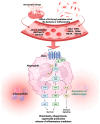Bioactive Compounds as Modulators of N-Formyl Peptide Signaling in Chronic Diseases
- PMID: 40733247
- PMCID: PMC12298040
- DOI: 10.3390/molecules30142981
Bioactive Compounds as Modulators of N-Formyl Peptide Signaling in Chronic Diseases
Abstract
In physiological situations involving cell damage, molecules derived from mitochondria or bacteria are produced. These molecules are known as N-formyl peptides and are detected by formyl peptide receptors (FPRs), which stimulate immune cells to migrate to the specific site of injury or infection. Despite their initially beneficial effects on health, N-formyl peptides also contribute to the development or exacerbation of chronic non-communicable diseases. Therefore, understanding the metabolic pathways related to the involvement of N-formyl peptides and FPRs may increase our ability to regulate immune responses and precisely target FPRs with personalized strategies, offering a promising approach for the treatment of specific diseases. In this way, bioactive compounds in food may influence N-formyl peptides, interacting with the receptors either competitively or by inhibiting them, which affects the inflammatory response and oxidative reactions of cells. This review examines the pathways associated with forming N-formyl peptides, the activation of FPRs, and the roles of bioactive compounds in regulating N-formyl peptides.
Keywords: N-formyl peptides; bioactive compounds; diet; formyl peptide receptors; non-communicable disease.
Conflict of interest statement
The authors declare no conflict of interest.
Figures





Similar articles
-
Formyl peptide receptor modulators: a patent review and potential applications for inflammatory diseases (2021-2024).Expert Opin Ther Pat. 2025 Aug;35(8):839-857. doi: 10.1080/13543776.2025.2515882. Epub 2025 Jun 11. Expert Opin Ther Pat. 2025. PMID: 40462544 Review.
-
The role of FPR2-mediated ferroptosis in formyl peptide-induced acute lung injury against endothelial barrier damage and protective effect of the mitochondria-derived peptide MOTS-c.Int Immunopharmacol. 2024 Apr 20;131:111911. doi: 10.1016/j.intimp.2024.111911. Epub 2024 Mar 24. Int Immunopharmacol. 2024. PMID: 38527401
-
Immunomodulatory potential of dietary soybean-derived saponins.J Anim Sci. 2024 Jan 3;102:skae349. doi: 10.1093/jas/skae349. J Anim Sci. 2024. PMID: 39529449 Review.
-
Systemic Inflammatory Response Syndrome.2025 Jun 20. In: StatPearls [Internet]. Treasure Island (FL): StatPearls Publishing; 2025 Jan–. 2025 Jun 20. In: StatPearls [Internet]. Treasure Island (FL): StatPearls Publishing; 2025 Jan–. PMID: 31613449 Free Books & Documents.
-
Management of urinary stones by experts in stone disease (ESD 2025).Arch Ital Urol Androl. 2025 Jun 30;97(2):14085. doi: 10.4081/aiua.2025.14085. Epub 2025 Jun 30. Arch Ital Urol Androl. 2025. PMID: 40583613 Review.
References
-
- Forsman H., Wu Y., Mårtensson J., Björkman L., Granberg K.L., Dahlgren C., Sundqvist M. AZ2158 Is a More Potent Formyl Peptide Receptor 1 Inhibitor than the Commonly Used Peptide Antagonists in Abolishing Neutrophil Chemotaxis. Biochem. Pharmacol. 2023;211:115529. doi: 10.1016/j.bcp.2023.115529. - DOI - PubMed
Publication types
MeSH terms
Substances
LinkOut - more resources
Full Text Sources

